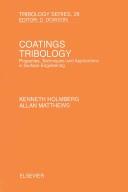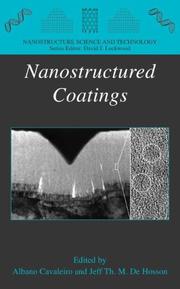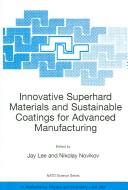| Listing 1 - 8 of 8 |
Sort by
|
Periodical
Abstract | Keywords | Export | Availability | Bookmark
 Loading...
Loading...Choose an application
- Reference Manager
- EndNote
- RefWorks (Direct export to RefWorks)
Protective coatings --- Paint --- Polymers --- Revêtements protecteurs --- Peinture (Produit chimique) --- Polymères --- Périodiques. --- Coating compositions --- Coatings --- Corrosion and anti-corrosives
Periodical
Abstract | Keywords | Export | Availability | Bookmark
 Loading...
Loading...Choose an application
- Reference Manager
- EndNote
- RefWorks (Direct export to RefWorks)
Corrosion and anti-corrosives --- Protective coatings --- Corrosion --- Revêtements protecteurs --- Anticorrosifs --- 51.22 surfaces, interfaces and thin layers --- Coating compositions --- Coatings
Book
ISBN: 9783869227269 3869227265 9783869223636 Year: 2020 Publisher: Berlin : DOM publishers,
Abstract | Keywords | Export | Availability | Bookmark
 Loading...
Loading...Choose an application
- Reference Manager
- EndNote
- RefWorks (Direct export to RefWorks)
The growing variety of materials available for interior applications makes the selection and sampling process evermore complex and timeconsuming. This book in the Construction and Design Manuals series offers an overview of all materials suited for walls, ceilings, and floors, as well as stand-alone objects. Traditional and new materials are described in a knowledgeable and practical manner, providing information and inspiration for creating interiors. It is not only the material itself that determines the appearance of a surface, but also the design and arrangement of the joints: next to the material surface, the chosen laying pattern is a key aspect that influences the spatial effect. This sampler therefore includes a large array of patterns. It conveys fundamental knowledge of materials and their applications, and thus serves as a reference book, a sampling guide, and a go-to compendium for students
Building materials --- materialen --- materialenleer --- naslagwerk --- bouw --- design --- architectuur --- kunst --- interieurvormgeving --- hout --- steen --- textiel --- 7.23 --- Architectural materials --- Architecture --- Building --- Building supplies --- Buildings --- Construction materials --- Structural materials --- Materials --- 691(03) --- Wanden ; muren ; vloeren ; plafonds ; bekledingen --- Architectuur; materialen --- Bouwmaterialen ; naslagwerken --- Revêtements de sol --- Revêtements muraux --- Plafonds --- Construction --- Matériaux --- 691 --- 692.2 --- 692.5 --- 692 --- 692 Structural parts and elements of buildings --- Structural parts and elements of buildings --- 692.2 Walls. Partitions --- Walls. Partitions --- 691 Building materials. Building components --- Building materials. Building components --- 692.5 Floors. Intermediate floors. Floorings. Ceilings --- Floors. Intermediate floors. Floorings. Ceilings --- Revêtements de sol --- Revêtements muraux --- Matériaux

ISBN: 0444888705 9786611789459 1281789453 0080875920 9780444888709 9780080875927 Year: 1994 Volume: 28 Publisher: Amsterdam New York Elsevier
Abstract | Keywords | Export | Availability | Bookmark
 Loading...
Loading...Choose an application
- Reference Manager
- EndNote
- RefWorks (Direct export to RefWorks)
This book presents a general view on thin surface coatings used for tribological applications and it is based on the current state of understanding. The mechanisms of friction and wear in sliding and rolling contacts of coated surfaces are described. Basic information on coating techniques, tribology and surface mechanisms is given. Based on collected experimental works information is given on the properties of thin soft coatings, such as polymer, lamellar solid and soft metal coatings; thin hard coatings, such as nitride, carbide, oxide, boride and diamond and diamond-like coatings; and multi
Coatings --- Tribology --- Revêtements --- Tribologie (Technologie) --- Tribology. --- Mechanical Engineering --- Engineering & Applied Sciences --- Mechanical Engineering - General --- Revêtements --- ELSEVIER-B EPUB-LIV-FT --- Coatings. --- Friction --- Surfaces (Technology) --- Surface coatings --- Materials --- Coating processes --- Thin films --- Revetement --- Revetements protecteurs --- Surface treatments --- Tribologie --- Tribologie (technologie) --- Revêtements. --- Traitements de surface. --- Surface preparation.
Book
ISBN: 9781119541769 111954176X Year: 2020 Publisher: Hoboken, New Jersey : John Wiley & Sons,
Abstract | Keywords | Export | Availability | Bookmark
 Loading...
Loading...Choose an application
- Reference Manager
- EndNote
- RefWorks (Direct export to RefWorks)
"Aluminum, the second book in Zahner's Architectural Metals Series, is a comprehensive and authoritative treatment of aluminum applications in architecture and art. This visual, full-color guide offers architecture and design professionals the information they need to ensure proper maintenance and fabrication techniques. Zahner's approach to the use of aluminum in architecture and art covers everything from the history of the metal and choosing the right alloy, to detailed information on a variety of surface and chemical finishes and corrosion resistance. Case studies offer architecture and design professionals strategies for designing and executing successful projects using aluminum. About the series: Zahner's Architectural Metals Series offers in-depth coverage of today's most commonly used metals in architecture and art. These heavily illustrated guides offer comprehensive coverage of how each metal is used in creating surfaces for building exteriors, interiors, and art finishes. Volumes in the series cover: Stainless Steel; Aluminum; Copper, Brass and Bronze; Steels; and Zinc." [Publisher]
Aluminum --- Aluminum coatings. --- Architectural metal-work. --- Aluminium --- Revêtements --- Ferronnerie d'art. --- Finishing. --- Surfaces. --- Finition. --- Aluminum coatings --- Architectural metal-work --- Art metal-work --- 691.7 --- Bouwmaterialen ; metalen ; aluminium --- Art metal-work, Primitive --- Decorative metal-work --- Metal-work, Art --- Decorative arts --- Metal-work --- Metal-work, Architectural --- Building fittings --- Protective coatings --- Group 13 elements --- Light metals --- Aluminum finishing --- Finishing --- Surfaces --- Bouwmaterialen ; metalen --- Corrosion --- Revêtements

ISBN: 9780387256429 0387256423 0387487565 9786610803514 1615831371 1441920641 1280803517 Year: 2006 Publisher: New York : Springer,
Abstract | Keywords | Export | Availability | Bookmark
 Loading...
Loading...Choose an application
- Reference Manager
- EndNote
- RefWorks (Direct export to RefWorks)
Controlling the performance of structures and components of all sizes and shapes through the use of engineered coatings has long been a key strategy in materials processing and technological design. The ever-increasing sophistication of en- neered coatings and the rapid trend toward producing increasingly smaller devices with greater demands on their fabrication, properties and performance have led to signi?cant progress in the science and technology of coatings, particularly in the last decade or two. Nanostructured coatings constitute a major area of sci- ti?c exploration and technological pursuit in this development. Withcharacteristic structural length scales on the order of a few nanometers to tens of nanometers, nanostructured coatings provide potential opportunities to enhance dramatically performance by offering, in many situations, extraordinary strength and hardness, unprecedented resistance to damage from tribological contact, and improvements in a number of functional properties. At the same time, there are critical issues and challenges in optimizing these properties with ?aw tolerance, interfacial adhesion and other nonmechanical considerations, depending on the coating systems and applications. Nanostructured coatings demand study in a highly interdisciplinary research arena which encompasses: surface and interface science study of defects modern characterization methodologies cutting-edge experimental developments to deposit,synthesize, conso- date, observe as well as chemically and mechanically probe materials at the atomic and molecular length scales state-of-the-art computational simulation techniques for developing - sightsintomaterialbehaviourattheatomicscalewhichcannotbeobtained in some cases from experiments alone The interdisclipinary nature of the subject has made it a rich playing ?eld for scienti?c innovation and technological progress.
Nanostructured materials. --- Coatings. --- Nanomatériaux --- Revêtements --- Chemical & Materials Engineering --- Engineering & Applied Sciences --- Materials Science --- Nanomatériaux --- Revêtements --- EPUB-LIV-FT LIVCHIMI SPRINGER-B --- Surface coatings --- Nanomaterials --- Nanometer materials --- Nanophase materials --- Nanostructure controlled materials --- Nanostructure materials --- Ultra-fine microstructure materials --- Materials science. --- Nanotechnology. --- Materials Science. --- Materials Science, general. --- Molecular technology --- Nanoscale technology --- High technology --- Material science --- Physical sciences --- Microstructure --- Nanotechnology --- Materials --- Surfaces (Technology) --- Coating processes --- Thin films --- Materials. --- Engineering --- Engineering materials --- Industrial materials --- Engineering design --- Manufacturing processes
Book
ISBN: 9783035611120 9783035609073 9783035608878 9783035611113 3035611122 3035609071 3035608873 Year: 2016 Publisher: Basel
Abstract | Keywords | Export | Availability | Bookmark
 Loading...
Loading...Choose an application
- Reference Manager
- EndNote
- RefWorks (Direct export to RefWorks)
Die bauphysikalischen und komfortrelevanten Eigenschaften zeichnen den Gips-Trockenbau als besonders nachhaltige und vielseitige Bauweise aus. Das Buch verknüpft das große architektonische und skulpturale Potenzial dieser Bauweise mit den konstruktiven Anforderungen. Sein Fokus liegt auf der Systemvielfalt, den spezifischen Abhängigkeiten und deren konsequenter Umsetzung in einer Entwurfsidee. Raumkonzeptionen und Elemente in Bestandsgebäuden oder Neubauten werden kategorisiert und ihre Umsetzung im Detail dargestellt. Zahlreiche Beispiele zur Detaillierung und Fügung von Bauteilen erläutern darüber hinaus den Wirkungszusammenhang von Licht, Farbe, Material, Oberfläche und Konstruktion.Zeichnungen in verschiedenen Maßstäben veranschaulichen die räumlichen und tektonischen Beziehungen. The building physics and comfort-relevant properties of gypsum drywall construction make it a particularly sustainable and versatile construction method. The book links the great architectural and sculptural potential of this building method with its construction requirements. Its focus is on the diversity of the system, its specific prerequisites, and its systematic implementation in design ideas. The space concept and elements in existing and new buildings are analyzed, and their implementation illustrated in detail. In addition, numerous examples of details and building components explain the effect of light, color, material, surface, and construction. Drawings at different scales illustrate the tectonic relationships in space.
Walls --- Drywall --- Murs --- Construction en pierres sèches --- Design and construction --- Conception et construction --- Wall coverings --- Revêtements muraux --- 691.1 --- Bouwmaterialen ; van organische oorsprong --- Bouwmaterialen; gips ; gipsplaten --- Constructie ; handboeken ; plaasterplaten ; gipsplaten --- Interior architecture. --- Lightweight construction. --- Drywall construction. --- Dry wall --- Dry-wall construction --- Building --- Construction, Lightweight --- Light construction --- Light weight construction --- Minimum weight construction --- Architectural interiors --- Architecture, Interior --- Interior space (Architecture) --- Interiors --- Space (Architecture) --- Revêtements muraux. --- Walls - Design and construction - Handbooks, manuals, etc. --- Drywall - Design and construction - Handbooks, manuals, etc. --- Lumière-architecture --- Construction en pierres sèches --- Revêtements muraux.

ISBN: 1402034695 1402034717 1402034709 9786610284092 1280284099 Year: 2005 Volume: 200 Publisher: Dordrecht ; [Great Britain] : Springer,
Abstract | Keywords | Export | Availability | Bookmark
 Loading...
Loading...Choose an application
- Reference Manager
- EndNote
- RefWorks (Direct export to RefWorks)
Modern industry imposes ever increasing requirements upon tools and tool materials as to the provision for performance under the conditions of high cutting speeds and dynamic loads as well as under intensive thermal and chemical interactions with workpiece materials. The industry demands a higher productivity in combination with the accuracy of geometry and dimensions of workpieces and quality of working surfaces of the machined pieces. These requirements are best met by the tool superhard materials (diamond and diamond-like cubic boron nitride). Ceramics based on silicon carbide, aluminum and boron oxides as well as on titanium, silicon and aluminum nitrides offer promise as tool materials. Tungsten-containing cemented carbides are still considered as suitable tool materials. Hi- hardness and high strength composites based on the above materials fit all the requirements imposed by machining jobs when manufacturing elements of machinery, in particular those operating under the extreme conditions of high temperatures and loads. These elements are produced of difficult-- machine high-alloy steels, nickel refractory alloys, high-tech ceramics, materials with metallic and non-metallic coatings having improved wear resistance, as well as of special polymeric and glass-ceramic materials. Materials science at high pressure deals with the use of high-pressure techniques for the development and production of unique materials whose preparation at ambient pressure is impossible (e. g. , diamond, cubic boron nitride, etc. ) or of materials with properties exceeding those of materials produced at ambient pressure (e. g. , high-temperature superconductors).
Hard materials --- Protective coatings --- Matériaux durs --- Revêtements protecteurs --- Congresses. --- Congrès --- Hard materials. --- Chemical & Materials Engineering --- Engineering & Applied Sciences --- Materials Science --- Matériaux durs --- Revêtements protecteurs --- Congrès --- Advanced EPUB-LIV-FT LIVCHIMI NATO SPRINGER-B Superhard Sustainable coatings manufacturing materials --- Engineering. --- Science. --- Physical chemistry. --- Condensed matter. --- Industrial engineering. --- Production engineering. --- Tribology. --- Corrosion and anti-corrosives. --- Coatings. --- Industrial and Production Engineering. --- Science, general. --- Tribology, Corrosion and Coatings. --- Condensed Matter Physics. --- Operating Procedures, Materials Treatment. --- Physical Chemistry. --- Hardness --- Materials --- Mechanical wear --- Chemistry, inorganic. --- Manufactures. --- Chemistry, Physical organic. --- Science, Humanities and Social Sciences, multidisciplinary. --- Manufacturing, Machines, Tools, Processes. --- Chemistry, Physical organic --- Chemistry, Organic --- Chemistry, Physical and theoretical --- Manufactured goods --- Manufactured products --- Products --- Products, Manufactured --- Commercial products --- Manufacturing industries --- Inorganic chemistry --- Chemistry --- Inorganic compounds --- Management engineering --- Simplification in industry --- Engineering --- Value analysis (Cost control) --- Chemistry, Theoretical --- Physical chemistry --- Theoretical chemistry --- Condensed materials --- Condensed media --- Condensed phase --- Materials, Condensed --- Media, Condensed --- Phase, Condensed --- Liquids --- Matter --- Solids --- Surface coatings --- Surfaces (Technology) --- Coating processes --- Thin films --- Anti-corrosive paint --- Atmospheric corrosion --- Metal corrosion --- Metals --- Rust --- Rustless coatings --- Chemical inhibitors --- Chemistry, Technical --- Fouling --- Weathering --- Paint --- Waterproofing --- Friction --- Manufacturing engineering --- Process engineering --- Industrial engineering --- Mechanical engineering --- Corrosion --- Deterioration --- Surfaces --- Superhard materials --- Sustainable coatings --- Advanced manufacturing --- NATO
| Listing 1 - 8 of 8 |
Sort by
|

 Search
Search Feedback
Feedback About UniCat
About UniCat  Help
Help News
News